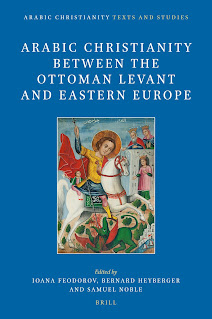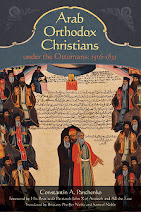Arabic original here.
The General Orthodox CouncilI would have preferred if it had been called the Great Orthodox Gathering and not the Council, because of the importance of distinguishing between the two things. It will be attended, as has been agreed, by twenty-four bishops from each of the fourteen Orthodox churches, whereas tradition holds that all bishops, no matter their number, may participate in an ecumenical council. Likewise, an ecumenical council is necessitated by the spread of some heresy that constitutes a threat to the Orthodox faith and a deviation from the true vision of God and this does not currently exist. The Christian faith in general and the Orthodox faith in particular face many challenges. The Church may be required on account of the danger that they pose to examine them and confront them. They do not, however, reach the point of a heresy that affects proper Christian dogma and issues of salvation in the manner of such heresies as Arianism and Iconoclasm which gained a dominant position and forced the Church to hold the ecumenical councils on account of them.
The dangers are very many in our world which is marked by individualism, consumerism, globalization and which appears to be undergoing a radical change in morality. Industrial society and technology has brought boredom, a lack of hope, isolation and loneliness alongside economic ease and scientific advancement. The more technological and scientific development increases, the need of humans increases for searching for the meaning and purpose of life.
What can be reasonably hoped for from this gathering is that it will be an expression of the single communion of faith that exists between the autocephalous Orthodox churches and that it will constitute a blessed opportunity to discuss the challenges that the faithful are facing in our current time. The gathering of brothers is a blessed event and a joy. In the Holy Bible it says, "Behold how good and pleasant it is for brothers to dwell in unity!" (Psalm 133:1). Nevertheless, as with all gatherings, this meeting also carries within it dangers and caveats.
Some of the faithful fear, for example, that this gathering will issue directives requiring the churches to adopt practices that might be unacceptable to the Orthodox consciousness, especially in the field of ecumenical relations; or that it might issue decisions that do not take into account situations that need time for the churches to discover the ideal and most appropriate formula, such as in the case of the churches of the diaspora; or that it may establish an approach to fraternal relations bearing a centralized orientation contrary to Orthodox tradition, the spirit of consultation, and Orthodox theology. Likewise the global, worldly mentality that is prevalent, globalization-- which has become a means for imposing a particular culture, local reactions that aim for self-protection from the oppressive globalist onslaught, and the hidden presence of local and international politics all constitute factors that necessitate further confronting all the challenges that have been posed with more of the spirit of maintaining purity of faith that distinguishes Orthodoxy, sobriety in dealing with its challenges, preserving right belief in it, starting out on the basis of evangelical truth, and listening to the voice of God through His living saints-- not through those who are called theologians merely because they have studied theology, and seeking the inspiration of the Holy Spirit first of all and last of all.
In principle, this meeting will examine six working papers, most of which are pastoral in nature. However, all pastoral activity is based on the vision that aims to help the faithful to realize their salvation and salvation is not realized apart from a pure and upright vision of the faith. The preliminary meetings that prepared this meeting were limited to the topics of fasting, marriage, the relationship of the Orthodox Church to the rest of the Christian world, her contribution to the contemporary world, the manner of declaring the autonomy of emerging churches, and the issue of the Orthodox diaspora-- which is the most important and the most subject to differences of opinion.
The difficulty in a gathering such as this lies in that it is taking place after more than a thousand years without there having been a gathering on this level. Most of the Orthodox churches have suffered during Christianity's second millenium (and continue to suffer) from extremely difficult historical circumstances. This historical suffering has engendered different mentalities and manners of dealing with pastoral issues and of confronting emerging challenges to the faith. The heavy and bitter history of the Orthodox has helped to make them inclined to hold on to what they have, even if in practice this sometimes turns into the very opposite. Refusing any change, adjustment or reform of practice is still abundantly widespread in all Orthodox milieux. The churches that are coming out of long, horrific persecution refuse to talk about reform and see it as a threat to uprightness of faith. For example, the positions of a church whose people do not know a mixed society or which is seeing itself torn apart from missionary activity by other Christians will not be receptive to dealing with the rest of the Christian world like a church whose people live, in peace, in a pluralistic society amidst diverse cultures.
Thus, historical factors and political circumstances play an influential role in raising the degree of sensitivity in terms of a certain political dimension for any issue under discussion. Likewise, many Orthodox peoples are witnessing a nationalist reawakening, while at the same time the Orthodox faith considers ethno-phylitism to be a heresy that is dangerous for Orthodoxy. This phenomenon will certainly cast its shadow over the meeting's atmosphere, even if only indirectly. Dreams of primacy, centralization, and authority, of First, Second and Third Rome, exist here and there. How will the issue of the Orthodox diaspora in the emigration be treated in such an environment?
The most important question, in my view, lies in the content of the final pastoral message, which the fathers who have gathered together will address to the faithful and to the world. In view of the very diverse and different pastoral visions among the churches, what answers and guidance will the meeting bring to the children of the Church and the world?
There is no doubt that the challenge is great. But faith in the presence and activity of the Holy Spirit is also great. Over the course of history, the Church has been subjected to dangers that almost put an end to her, but her Lord has preserved her through ways that He alone knows and creates. There is no doubt that the Church is full of pure and righteous people in whom the Holy Spirit will work and whom He will use to steer the ship to the best port. Our hope is that the voice of the living saints will be heard.
The gathering in itself, after a millennium, is a major accomplishment. If it does not succeed, then it will have prepared souls and hearts for joint work and the exchange of experiences in a more effective and impactful way in the future. It remains for all the faithful-- those who are enthusiastic about it, those who are apprehensive of it, and those who reject it-- to accompany it with fervent prayer and purity of life so that the Holy Spirit alone may be sovereign over it.








